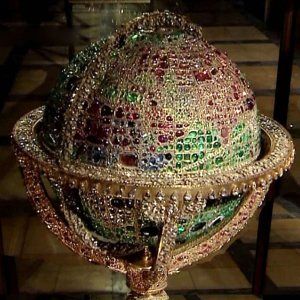Each piece of the collection tells a part of Iran’s turbulent history. The earliest jewelries with recorded dates belong to the Safavid era (1501-1736), though there also are older items but without exact dates.
It was the Safavid royal treasury that was first mentioned by foreign visitors such as French gem merchant and traveler Jean-Baptiste Tavernier (1605-1689), French jeweler and traveler Jean Chardin (1643-1713) and English adventurer brothers Anthony and Robert Shirley (1565-1635 and 1581-1628) among others.
Shah Abbas I (1588-1629) had a vast collection of jewels as Iran grew rich from the spoils of war, gifts and from traveling jewelers and envoys he sent to search for the rarest specimens in Constantinople, Venice and India.
The next major contribution to the treasury was by Nader Shah of the Afshar Dynasty. He amassed great riches, including the former Safavid crown jewels, which he recaptured from the Afghans.
Some 50 large gems in the collection are engraved with names of rulers and the date of their reign. A decanter in the collection is a unique example of Zand (1751-94) enameling on gold. A pair of solid gold candlesticks, each weighing 5kg and encrusted with gems, probably dates to the time of Fat’h-Ali Shah Qajar (1771-1834).
The buckle of Naser al-Din Shah Qajar’s gold belt consists of a velvet-green 175-karat emerald in a diamond frame. The scabbard of a saber presented to him by vizier Amin al-Soltan contains close to 3,000 gems. More dazzling than the scabbard is the Pahlavi crown glittering with 3,380 diamonds.
Source: Financial Tribune

